I saw a post on Facebook, linking to an article while giving the following description:
A bunch of the most sensible observations and advice about dog parks I’ve ever seen, from the ever-practical Blanche Axton.
Eileenanddogs
So, I decided to take a good look through this one, especially looking for what is so sensible and ever-practical. And maybe comparing this to the dog park guide that I first wrote some years ago. What I did found remarkable was that nearly every single paragraph either had items I strongly disagreed with or things that simply did not seem to make any sense at all. Most times I just ignore these types of articles. Except that this was endorsed by a frequent writer on dog behavior, who I thought was a bit more critical than this.
As I’ve already written about Dog Parks elsewhere, this article is limited to reviewing Blanche’s advice.
Be Careful!
I am very careful about using a dog park. I avoid most of them and tend to use ones with LOTS of space. And I carefully check out any park before I use it.
Blanche Axion
Okay, that’s only her first paragraph, but I’m already starting to wonder. You see, one of the more certain things in this world is that, no matter where you might go, sooner or later an idiot will come along. The very large dog parks often have several entrances, and you might not even see the idiot coming in the far entrance in time to reach your dog.
Sure, this is okay once your dog is a park expert, but not when he’s just learning.
For Only the Sophisticated!
It takes sophisticated social skills to successfully navigate that kind of cocktail party (the same goes for the dog park) dogs need VERY good social skills to manage the dog park.
Why would that be true? Well, at the dog park they might just meet two dozen new dogs for the first time. In order for your dog to acquire the social skills to do that, what would he need to do? I’ll take a guess at that: he’d have to meet two dozen dogs for the first time.
I wonder, how would he ever do that? Where might you find those dogs?
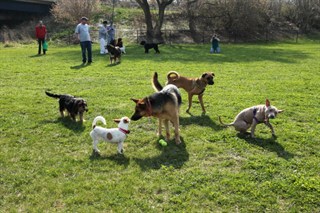
While she doesn’t mention alternatives, you could take him to play dates. However, even if you find some, that’s often with only one or two other dogs, and slowly meeting new dogs with people controlling the situation is a far cry from having a dozen new dogs walking over to you. Quite different, for both dogs and people.
Or, he could go to a playgroup at a local trainer/boarder, but those dogs are first evaluated, and there’s always somebody walking around to keep things fairly quiet. In other words, the dogs don’t get to practice the social skills needed to manage relationships and prevent issues. At least, not nearly to the same degree.
For that matter, what about the random dogs often found in animal shelters? And groups like Dogs Playing for Life, who teach shelters how to start playgroups, rapidly teaching all those sophisticated social skills? More locally, below we have playgroups at the Animal Welfare Department in Albuquerque, NM. During one 3-year period, over 3,500 dogs learned and enjoyed the playgroups.
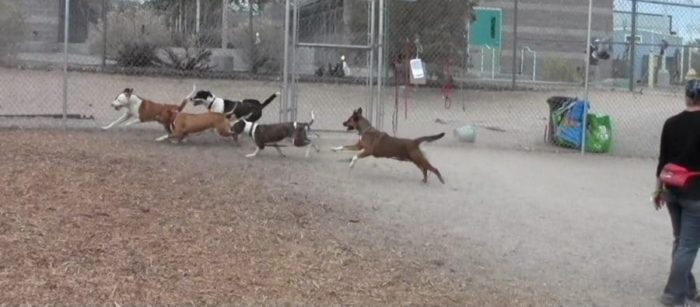
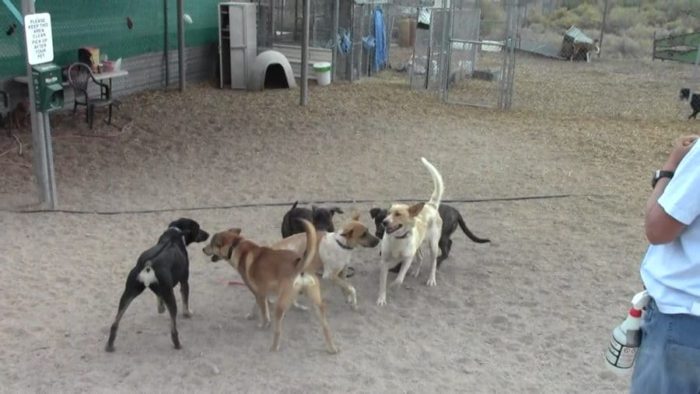
Bring your notebook
Check out the park numerous times at different times and on different days BEFORE you take your dog.
For sure! And I wrote about that also. However, I never suggested (or imagined) that anybody made multiple trips over times and days before first entering. Nor can I even imagine anybody ever doing that. Spend some time to take a good look, sure, but let’s not take that to excess.
Is the park interesting from a dog’s perspective? Are there trees, creeks, interesting objects around that don’t pose a risk to your dog? As an example, I love a park that mixes woody areas with grassy areas and a big bonus if there is a water feature like a creek
Where she says “I love a park that…”, were those her dog’s words, or hers? I take my dog many places, some with trees and creeks, but the main attraction of dog parks for him happens to be dogs. Maybe not so much for her, I suppose.
Is there agility equipment or other dog sports equipment there? If so, I don’t go. A bunch of dogs running around agility equipment is a recipe for (1) over arousal and (2) an injury. Both of my dogs DO agility and have had the requisite training to use the equipment, but I sure wouldn’t let them run equipment in a dog park with a bunch of other dogs around.
A recipe for over arousal? At one point we had over two dozen dogs romping in the dog park, divided into about four different activity groups. A Cheerleader gave out a cry and took off, with a dozen dogs wildly running after her. Another half-dozen dogs were wildly and loudly running the fence, with a little Chi they all loved on the other side. Two Cattle Dogs were competing for thrown balls, ignoring all the others.

Over an hour later, nobody was over aroused. Nobody was injured. And this happened hundreds of times.
I find it rather odd that her dogs have had the requisite training to use agility equipment. For the typical items you might see in a dog park, I really cannot understand why your dog would need specific training in order to use that. Isn’t that like saying you cannot walk your dog down the street until you first train him on curbs? And, what is her problem with the dogs running on equipment with other dogs around?
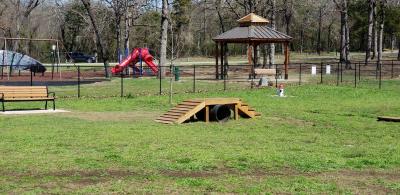
How big is the park? Is it big enough that even if there seem to be a lot of dogs, you can get away and go off and have a nice walk without the risk of too many dogs getting too excited?
If I wanted to take my dog for a nice walk, what am I doing in a dog park? And why would those other dogs get too excited? She seems to be making many assumptions about things she’s not saying.

Wear good shoes?
What is the footing in the park? Is it sand? Gravel? Wood chips? Artificial grass? All of these pose some risks and make keeping the park clean harder and increase some risk of parasites. Also many dogs with sight deficits will find any kind of footing that isn’t completely stable off putting and scary. I, personally, prefer plain old dirt and grass
Really? Plain dirt tends to blow away, get muddy, and get into everything. Grass is always nice, but requires about the most maintenance of any ground cover. Gravel usually provides the best drainage, with less risk of parasites than her choices.
On dogs with sight deficits and footing, wood chips are about the only likely issue, but you’d really have to ask the dog about that. And if the dog’s that bad, what are you doing in a dog park?
Maybe whiplash?
Beware of the potential risks to running a dog on very wet or very icy ground. It’s a fast way to a cruciate injury. I don’t ever use a chuck-it with any dog that likes fetch. Most canine physiotherapists flinch and go pale when they hear people saying they use a chuck-it as it increases the risk of an injury due to the speed and the sudden stop and start.
My dog runs far more in the field than the dog park, but I’m not running myself on wet or icy ground, in a dog park or not. In other words, I have no idea what that statement is doing here.
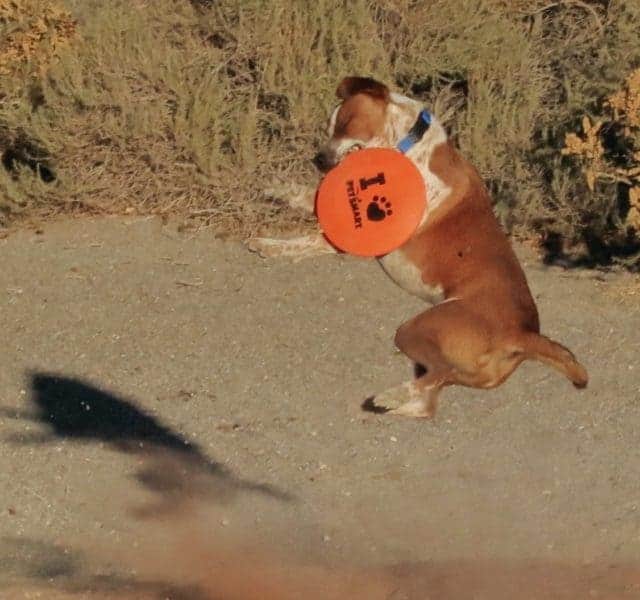
Next, she’s implying that a chuck-it is more dangerous than throwing by hand, as it causes a more sudden stop and start. If I throw the ball faster, the dog will start faster? And a chuck-it causes a sudden stop? That physics escapes me. On her physiotherapist claim, it sounds so very far out that I have no idea what to do with it.
If it’s sudden starts that concern her, she should check out the AKC Lure Coursing events. Some of the groups have opened it up to general breeds, and my dog used to love it. And what about Dog Flyball?
Access to a water source, but not necessarily random dog bowls full of slimy water.
* Garbage containers for dog bag disposal. It’s nice if the park HAS dog poop bags, but I always bring them as it’s not always reasonable to expect a park to provide them
Well, here I’ll have to agree, as I don’t like slimy water ether. But, why would the dog bowls be random? Should we measure where they are placed? What does that even mean?
Well, garbage containers are okay, but most of them are somewhat open on the top, which gets pretty stinky when it’s hot outside. Most dog parks around here have poop bag dispensers that also collect the poop on the side.
What she doesn’t want to see
A small space with no real way to move away and not enough room to actually have a walk.
There we go, again with the walk thing. And what is it that she has to move away from? When my dog takes a sniffing walk around the dog park, he’s walking right by many other dogs. So what? A few may come over to say hello or offer to play, then they walk off. So what?
Puppies. Most will NOT learn anything at a park except how to play too roughly or that other dogs are scary and overwhelming. You can accidentally create a reactive dog by taking your pup to a dog park. DOG PARKS ARE DREADFUL PLACES TO TRY AND SOCIALIZE YOUR DOG.
The start of her statement strongly implies that, in general, most dogs at a park play too roughly. If that’s what she believes, then why does she bother saying anything more?
Sometimes at the dog park, you may find mostly newbies and random dogs. Sure, that may not be great for pups. However, when the social regulars are there, there are usually a few adults who like teaching the pups. And what they do is pretty much the opposite of what she says. I’ve seen hundreds of pups and young dogs learn social skills there. Yes, some pups go wild, but the social adults will make them take breaks to calm down. And they may end up rolling in the dirt with a few other pups, with a couple of adults laying a few feet away and enjoying the action.

I have to wonder if she has any concept of how dogs learn behaviors and social skills without humans carefully controlling everything? There are millions of Paria Dogs and Dump Dogs who are just fine on their own. On the other side, there are many dogs living with people that are afraid to walk by another dog or a stranger.
I took dozens of reactive dogs from the Albuquerque shelter, gave them some initial training, then off to the dog park to learn social skills, politeness, and how to meet a variety of dogs. Sure, I could have done that without using the dog park, but this way accomplished in weeks or even days, which might have taken months. And these were dogs that trainers and staff at the shelter couldn’t turn around, as they had limited time and lacked the resources. These formally reactive dogs then passed temperament tests and were adopted.
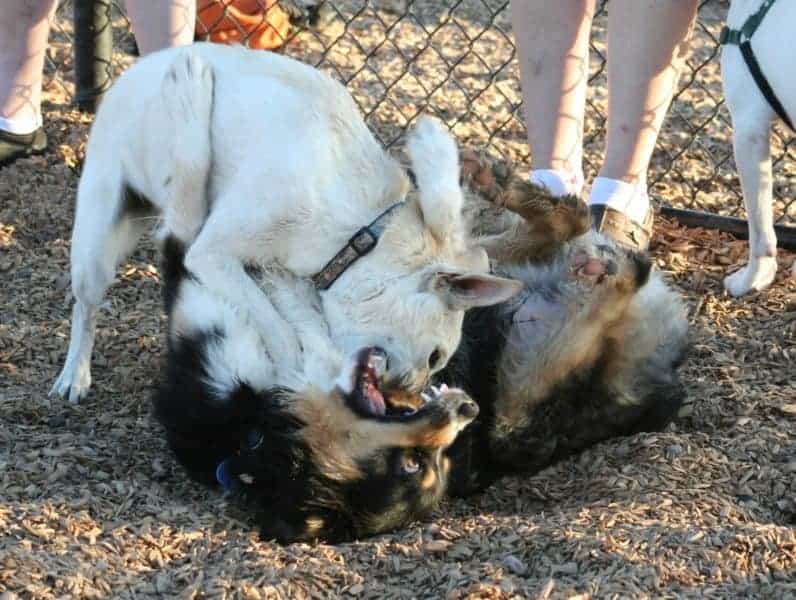
Many were adopted as a 2nd dog, which often requires a human-mediated Meet-and-Greet to introduce the two dogs. However, all of these dogs already had the social skills to simply handle it themselves, and often taught some of this to the resident dogs. Which has me wondering, could Blanche’s dog do that?
There were also a number of local dogs where their people could hardly walk them because they became so reactive when even seeing other dogs pass by. Most had been through dog trainers, to no avail. After the dog park training, they were not only calmer when walking, but the dog knew how to handle it if a loose dog should run over to him.
After all, he’s already handled that hundreds of times before.
Dogs that are clearly uncomfortable being there and either cringing away from other dogs or aggressively reacting to other dogs.
At the extreme level, yes. But, some degree of that is pretty common for many newbies. We’ve had some dogs come in and cringe when a bunch of dogs comes over to say hello. They will gently sniff, then walk away. If one gets too close to her face, she’ll growl and maybe an air snap. The socialized adult dog will understand that simply means she’s scared, and calmly walk away.
No, of course not all dogs you may find in a dog park are like that. Perhaps only a few thousand or so in each community. Now, I don’t really know if Blanche would think that growl and air snap are aggression. But, I really hope not, as I’ve written elsewhere on just what that means, and the potential problems from stopping it.
Dogs that have not been with their owners for very long (Under 6 months to a year).
One could make a case for this one, except that I use 1-2 weeks instead. What does she think is going to happen over those six months?
Owners who are ‘Dog Park Cesar Millans’. These folks are often intrusive, won’t take no for an answer and usually don’t have any real knowledge or skills but think they do
Well, finally, I’ll agree with her on this one. There are few people worse than him.
Everybody, pick up all your toys!
Random toys lying around. I hate to sound like everyone’s grandmother, but ‘you don’t know where that toy has been’ and I see WAY too many dog fights over resource guarding toys.
Oh, my! I don’t know where that toy has been, or who might have walked on that ground! There’s a large bowl with clean water, but two other dogs just drank, so do I need to clean it before letting my dog drink?
My grandmother was never that bad.

She sees too many fights over resource guarding! And says that as though she believes that issue is a common problem. I used to see that occasionally, with a new dog coming in, but we’d get him past that pretty quickly. After all, a park with social dogs can be the absolute best place for a dog to practice sharing toys. Provided, of course, that he’s had some initial socialization and isn’t too anxious to learn.
Large groups of dogs running at speed and with little control. This kind of interaction is a recipe for injury, dog fights and small dogs getting grievously injured.
What is this out of control thing? Are they tripping over their own feet? On little dogs, we used to a have a Chi who ran with the big guys. Whenever things got too dicey, he’d run under his big GSD friend for some shelter.

Some summer nights we used to have laser runs. Over a dozen dogs running, with a couple chasing the laser pointer, and the rest chasing them for the fun. It would go on for hours, with never a fight or injury.
At this point I really have to ask, do her dogs ever have any fun? I mean, do stuff that they would like to do?
In conclusion
I have the impression that Blanche is familiar with obedience training and trained dogs, but doesn’t really know many socially skilled dogs. Over the past decade at our local dog park, I’ve seen some issues, but also many hundreds of socially skilled dogs. Unlike Blanche, I’ve don’t believe that I’ve ever seen anybody go in a dog park just to take a walk unless the park was really big. The regulars usually just release their dogs and come in, then go sit on a bench or stand around and talk. Their dogs all know how to behave, and anything starting to go wrong usually has several people alerting together, the very instant they hear an expletive.
But, maybe this is a different world from Blanche’s, with different people and different dogs. If so, then she can have her world, and I’d rather stay in mine.
